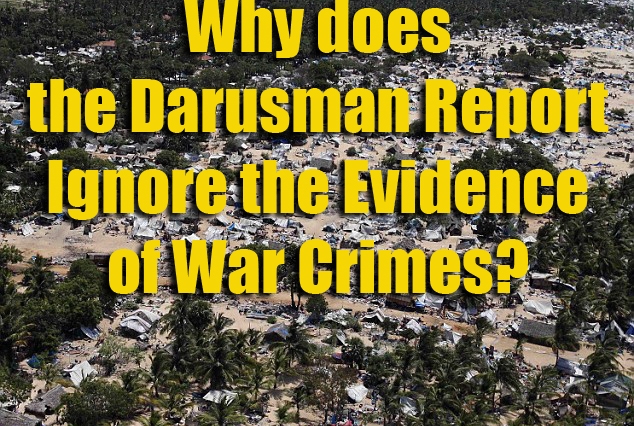
Why does the Darusman Panel Ignore Evidence of War Crimes?
In June 2010, UN Secretary General Ban Ki Moon appointed a panel to investigate and and advise him on the possibility of large scale human rights violations in the closing stages of the war in Sri Lanka, primarily in the first quarter of 2009. This was done close on the heels of the UN Human Rights Council’s rejection of a call by advocacy groups for a full-scale international investigation. Ban appointed his Special Rights Investigator to North Korea, Marzuki Darusman, as the panel’s chair and, in April 2011, the panel released its report. This report has been variously viewed by the different parties. At one end of the spectrum it is seen as totally biased and unfair by the government of Sri Lanka, and at the other end as proof of genocide by the Tamil nationalists. Somewhere in the middle, most balanced observers have seen it as a scathing indictment against both the victorious Sri Lankan military and the defeated Liberation Tigers of Tamil Eelam (LTTE). Certain international advocacy groups such as Amnesty International, the International Crisis Group, and Human Rights Watch, then immediately mounted a media campaign accusing the GoSL of war crimes, and one particularly contentious issue is that in this campaign, the panel’s use of the phrase “credible allegation” has been replaced by that of “credible evidence”, giving the impression that the panel has evidence of war crimes committed by the GoSL. The recently aired Channel 4 documentary, Sri Lanka’s Killing Fields, opens with this lie.
In reality, the panel uses the phrase only twice; in the positive, saying that it had credible evidence that superiors in the Sri Lankan chain of command were responsible for any violations committed by their subordinates; and in the negative, claiming to have no credible evidence of the LTTE’s use of human shields. Everywhere else, the term used is that of credible allegations. At no point does the Darusman Report reveal what evidence it examined, which portions were deemed credible, and which portions were rejected. Nor does it explain how an allegation was deemed credible, and whether this credibility was based on actual evidence, eyewitness testimony, or both. In spite of this, legal minds contend that credible evidence is necessary for an allegation to be termed credible, though it is unclear as to how the Darusman panel adjudged credibility.
Let’s take the statement by the panel that they cannot find credible evidence of the Tigers using civilians as human shields. This is what the report says:
“…With respect to the credible allegations of the LTTE’s refusal to allow civilians to leave the combat zone, the Panel believes that these actions did not, in law, amount to the use of human shields insofar as it did not find credible evidence of the LTTE deliberately moving civilians towards military targets to protect the latter from attacks as is required by the customary definition of that war crime (Rule 97, ICRC Study).”
Rule 97 of the Customary International Humanitarian Law, as set out by the ICRC, prohibits the use of human shields, and is based on a number of customary practices, international conventions, military manuals, and state laws which are cited in support of Rule 97.
Now, given that in addition to eyewitness testimonies to the fact, there exists video footage shot by unmanned aerial vehicles (UAVs) of the Sri Lanka Air Force which clearly show violations of Rule 97, the Darusman report seems to fly in the face of the actual evidence. Continue reading “Why does the Darusman Panel Ignore Evidence of War Crimes?”
